Korean J Ophthalmol.
2005 Mar;19(1):55-61. 10.3341/kjo.2005.19.1.55.
Change of Eye Position in Patients with Orthophoria and Horizontal Strabismus under General Anesthesia
- Affiliations
-
- 1Department of Ophthalmology, Uijongbu St. Mary's Hospital, College of Medicine, The Catholic University of Korea, Seoul, Korea. leeyc@cmc.cuk.ac.kr
- 2Department of Ophthalmology, Dongsan Medical Center, College of Medicine, Keimyung University of Korea, Deagu, Korea.
- KMID: 1099086
- DOI: http://doi.org/10.3341/kjo.2005.19.1.55
Abstract
- We studied the relationship between eye position in the awakened state and in the surgical plane of anesthesia in orthophoric and horizontal strabismus patients. We classified 105 orthophoric and horizontal strabismus patients into 5 groups, measured the eye position at the primary position by photographic measurement of the corneal reflex positions and undertook a quantitative study of eye position. Under general anesthesia, the mean divergence was 39.7 +/- 8 PD for the esotropia group, 36.6 +/- 11.7 PD for exophoria, 27.4 +/- 8.1 PD for orthophoria, and 11.1 +/- 10.2 PD for exotropia I (< or=30 PD). Therefore, the esotropia group had the largest amount of divergence among the groups, but the eye position of the exotropia II (> 30 PD) group was rather convergent at 11.0 +/- 6.5 PD. According to the eye position of the fixating and nonfixating eyes in the esotropia group, both eyes converged with an angle deviation of 14.4 +/- 4.8 PD divergent and 14.1 +/- 4.8 PD divergent, respectively (P=.71). In the exotropia groups (I, II), the fixating eye diverged but the nonfixating eye rather converged. Therefore, the angle deviation was 19.0 +/- 2.1 PD divergent for the fixating eye and 18.2 +/- 6.4 PD divergent for the nonfixating eye (P=.68). In conclusion, under general anesthesia, eye positions in the awakened state and in the surgical plane of anesthesia were convergent or divergent, and showed a tendency to converge into the position of 25-35 PD divergent. Therefore, we could not distinguish fixating eye from nonfixating eye under general anesthesia.
Keyword
MeSH Terms
Figure
Cited by 1 articles
-
Changes in Angular Deviations under General Anesthesia for Strabismus Surgery with Objective Anesthetic Depth Control
Chang Zoo Kim, Ki Yup Nam, Seung Uk Lee, Sang Joon Lee
J Korean Ophthalmol Soc. 2018;59(9):848-853. doi: 10.3341/jkos.2018.59.9.848.
Reference
-
1. Grut HE. A contribution to the pathogeny of concomitant squinting. Trans Ophthalmol Soc UK. 1890. 10:1.2. Möller PM. Influence of anesthesia and premedication on the squint angle. Acta Ophthalmol. 1958. 36:499–501.3. Lee SY, Seong GJ, Kim HB. Eye position of strabismus patients under general anesthesia. J Korean Ophthalmol Soc. 1987. 28:117–120.4. Kim SJ, Oh JS, Kim JM. A study of the change in angle deviation under general anesthesia in horizontal strabismus patients. J Korean Ophthalmol Soc. 1989. 30:115–122.5. An GJ, Cho YA, Jung HR. The change of the squint angle under general anesthesia using pancuronium bromide (Myoblock®). J Korean Ophthalmol Soc. 1989. 30:773–778.6. Lim ST, Kim SJ, Park YG. A clinical study: change of the eye position under general anesthesia. J Korean Ophthalmol Soc. 1995. 36:2243–2251.7. Lee DS, Kim SY. Eye position of orthophoric patients under general anesthesia. J Korean Ophthalmol Soc. 2001. 42:1303–1308.8. Brenin GM. The position of rest during anesthesia and sleep. Arch Ophthalmol. 1957. 57:323–326.9. Cattel HW. Post-mortem pathology. 1905. Philadelphia: JB Lippincott;73.10. Moses RA. Adler's physiology of the eye. 1970. St. Louis: CV Mosby;75.11. Burford G. Involuntary eyeball motions during anesthesia and sleep, relationship to cortical rhythmic potentials. Anesth Anal. 1941. 20:191.12. Worth C, Chavasse B. Squint. 1959. 9th ed. London: Bailliere Tyndal & Cox;714–718.13. France NK, France TD, Woodburn JD Jr, Burbank OP. Succinylcholine alteration of the forced duction test. Ophthalmology. 1980. 87:1282–1287.14. Mindel JS, Raab EL, Eisenkraft JB, Teutsch G. Succinyldicholine-induced return of the eyes to the basic deviation. Ophthalmology. 1980. 87:1288–1295.15. Lingua RW, Azen S, Szirth B, et al. Succinylcholine as a predictor in strabismus surgery. J Pediatr Ophthalmol Strabismus. 1983. 20:145–148.16. Lee IS, Jin YH. Succinylcholine induced - ocular position under the general anesthesia. J Korean Ophthalmol Soc. 1987. 28:387–391.17. Lingua RW, Azen SP, Walonker F, et al. A comparison of the succinylcholine induced ocular position and the postoperative alignment in strabismus. J Pediatr Ophthalmol Strabismus. 1986. 23:69–73.18. Hirschberg J. Beitrage zur Lehre vom Schielen und von der Schieloperation. Centralbl prakt Augenh. 1886. 10:5–9.19. Apt L, Isenberg S. Eye position of strabismus patients under general anesthesia. Am J Ophthalmol. 1977. 84:574–579.20. Romano P, Gabriel L. Intraoperative adjustment of eye muscle surgery. Correction based on eye position during general anesthesia. Arch Ophthalmol. 1985. 103:351–353.21. Ohmi E, Oguri K, Yoshiya I, Kitamura S. Eye position of squinting eyes during general anesthesia. Acta Ophthalmol Jap. 1975. 79:540.22. Mitsui Y, Tamura O, Hirai KI, et al. An electromyographic study of esotropia. Br J Ophthalmol. 1981. 65:161–166.23. Donders FC, Moore WD. On the anomalies of accommodation and refraction of the eye. 1864. London: New Sydenhan Society.24. Duke-Elder S. System of ophthalmology. 1973. Vol. 6. St. Louis: CV Mosby;96.25. Barry JC, Backes A. Limbus versus pupil center for ocular alignment measurement with corneal reflexes. Invest Ophthalmol Vis Sci. 1997. 38:2597–2607.26. Lee JA, Lee HY. New method for measurement of strabismic angle using corneal reflex and photograph. J Korean Ophthalmol Soc. 2002. 43:1988–1992.27. Brodie SE. Photographic calibration of the Hirschberg test. Invest Ophthalmol Vis Sci. 1987. 28:736–742.28. McKenzie AG. Prelude to pancuronium and vecuronium. Anaesthesia. 2000. 55:551–556.
- Full Text Links
- Actions
-
Cited
- CITED
-
- Close
- Share
- Similar articles
-
- The Change of the Squint Angle Under General Anesthesia Using Pancronium Bromide(Myoblock(R))
- Eye Position of Strabismus Patients Under General Anesthesia
- A Clinical Study: Change of the Eye Position under General Anesthesia
- Change of Eye Position after Strabismus Surgery under General Anesthesia
- A Study of the Change in Angle Deviation under General Anesthesia in Horizontal Strabismus Patients




